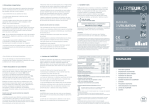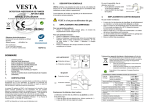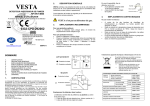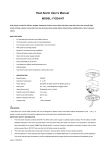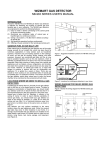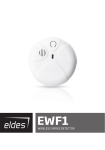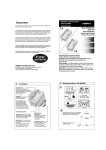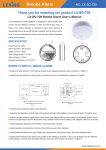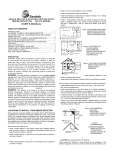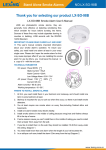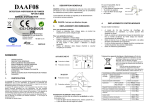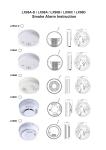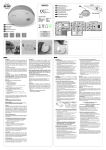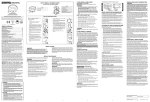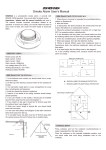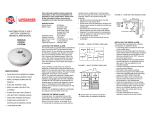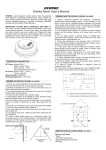Download Specifications
Transcript
WHERE TO INSTALL YOUR SMOKE ALARM SINGLE STATION PHOTOELECTRIC SMOKE ALARM NB739 SERIES NB739B SERIES USER’S MANUAL IMPORTANT: READ ALL INSTRUCTIONS BEFORE INSTALLATION. USER REPLACEABLE PARTS INSIDE THIS SMOKE ALARM. Do not attempt to repair the smoke alarm yourself. RETURN TO SUPPLIER FOR REPAIRS. INTERCONNECTABLE (38 UNITS), HUSH CONTROL. Specifications Power Source: Alkaline Battery : Energizer #522, Eveready #1222, #216; Duracell #MN1604; Carbon zinc battery: Gold Peak #1604P, #1604S; Lithium Battery: Ultralife U9VL-J-P, EVE CR9V/P Operating Current (Max): Operating Temperature: Ambient Humidity: Interconnecting: Horn Level: Approved: 25mA 0°C to 45°C 10% to 90% 38 Alarms over 150 meters maximum 85 dB at 3 meters minimum Figure 1: LOCATIONS FOR SMOKE ALARMS FOR A SINGLE RESIDENCE WITH ONLY ONE SLEEPING AREA Figure 2: LOCATIONS FOR SMOKE ALARMS FOR SINGLE-FLOOR RESIDENCE WITH MORE THAN ONE SLEEPING AREA Smoke alarms should be installed in accordance with the NFPA 74 (National Fire Protection Association, Battery march Park, Quincy, MA 02169, USA). For complete coverage in residential units, smoke alarms should be installed in all rooms, halls, storage areas, basements, and attics in each family living unit. Minimum coverage is one smoke alarm on each floor and one in each sleeping area. Here are some useful tips for you: ˙ Install a smoke alarm in the hallway outside every separate bedroom area, as shown in Figure 1. Two smoke alarms are required in homes with two bedroom areas, as shown in Figure 2. ˙ Install a smoke alarm on every floor of a multi-floor home or apartment, as shown in Figure 3. ˙ Install a minimum of two smoke alarms in any household. ˙ Install a smoke alarm inside every bedroom. ˙ Install smoke alarms at both ends of a bedroom hallway if the hallway is more than 12 m (40 feet) long. ˙ Install a smoke alarm inside every room where one sleeps with the door partly or completely closed, since smoke could be blocked by the closed door, and a hallway alarm may not wake up the sleeper if the door is closed. Figure 3: LOCATION FOR PLACING SMOKE ALARMS FOR A MULTI-FLOOR RESIDENCE INTRODUCTION Wizmart’s single station photoelectric smoke alarm is designed to sense smoke that enters the alarm chamber. It does not sense gas, heat, or flame. The smoke alarm is designed to give early warning of developing fires by emitting alarm sounds from its built-in alarm sounder. It can provide precious time for you and your family to escape before a fire spreads. However, the smoke alarm makes such pre-warning of fire accident possible only if the device is located, installed, and maintained properly as described in this User's Manual. WARNING: This smoke alarm is designed for use in a single residential unit only, which means that it should be used inside a single family home or apartment. It is not meant to be used in lobbies, hallways, basements or another apartment in multi-family buildings, unless there are already working alarms in each family unit. Smoke alarms, placed in common areas outside of the individual living unit, such as on porches or in hallways, may not provide early warning to residents. In multi-family buildings, each family living unit should set up its own alarms. WARNING: This smoke alarm is not designed for use in non-residential buildings. Warehouses, industrial or commercial buildings and special purpose non-residential buildings require special fire detection and alarm systems. This smoke alarm alone is not a suitable substitute for a complete fire detection systems for places where many people live or work, such as hotels or motels. The same is true of dormitories, hospitals, nursing homes or group homes of any kind, even if they were once single family homes. Please refer NFPA 101, the Life Safety Code, NFPA 71, 72A, 72B, 72C, 72D, and 72E for smoke alarm requirements for fire protection in buildings not defined as “households”. WARNING: This smoke alarm will not alert people who are hard of hearing. It is strongly recommended that the special-purpose smoke alarms, using lights or vibrating devices, should be installed to alert occupants who are hard of hearing. ˙ Install smoke alarms at the bottom of the basement stairwell. ˙ Install second-floor smoke alarms at the top of the first-to-second floor stairwell. ˙ Be sure no door or other obstruction blocks the smoke path to the smoke alarm. ˙ Install additional alarms in your living room, dining room, family room, attic, utility and storage rooms. ˙ Install smoke alarms as close to the center of the ceiling as possible. If this is not practical, put the alarm on the ceiling, no closer than 10 cm (4 inches) from any wall or corner, as shown in Figure 4. ˙ If some of your rooms have sloped, peaked, or gabled ceilings, try to mount alarms 0.9 m (3 feet) measured horizontally from the highest point of the ceiling as shown in Figure 5. Figure 5: RECOMMENDED LOCATION TO MOUNT SMOKE ALARMS IN ROOMS WITH SLOPED, GABLED, OR PEAKED CEILING CAUTION (As required by the California State Fire Marshall) “Early warning fire detection is best achieved by the installation of fire detection equipment in all rooms and areas of the household as follows: (1) A smoke alarm installed in each separate sleeping area (in the vicinity, but outside of the bedrooms), and (2) Heat or smoke alarms in the living rooms, dining rooms, bedrooms, kitchens, hallways, attics, furnace rooms, closets, utility and, storage rooms, basements and attached garages.” For your information, NFPA 74, Section 2-4 reads as follows: “2-4.1.1 Smoke alarms shall be installed outside of each separate sleeping area in the immediate vicinity of the bedrooms and on each additional story of the family living unit including basements and excluding crawl spaces and unfinished attics. The provisions of 2-4.1.1 represent the minimum number of alarms required by this standard. It is recommended that the householder consider the use of additional smoke alarms for increased protection for those areas separated by a door from the areas protected by the required smoke alarms under 2-4.1.1 above. The recommended additional areas are living room, dining room, bedroom(s), kitchen, attic (finished or unfinished), furnace rooms, utility room, basement, integral or attached garage, and hallways not included in 2-4.1.1 above. However, the use of additional alarms remains the option of the householder.” We recommend complete coverage and use of additional smoke alarms. WHERE TO INSTALL YOUR SMOKE ALARMS IN MOBILE HOMES AND RVs Mobile homes and RVs built after about 1978 were designed and insulated to be energy-efficient. In mobile homes and RVs built after 1978, smoke alarms should be installed as described above. Older mobile homes and RVs may have little or no insulation compared to current standards. Outside walls and roofs are often made of non-insulated metal, which can transfer thermal energy flow from outdoors. This makes the air right next to them hotter or colder than the rest of the inside air. These layers of hotter or colder air can keep smoke from reaching a smoke alarm. Thereby, install smoke alarms in such units only on inside walls. Place them between 10 ~ 15 cm (4 ~ 6 inches) from the ceiling. If you are not sure how much insulation is in your mobile home or RV, then install the alarm on an inside wall. If the walls or ceiling are unusually hot or cold, then install the smoke alarm on an inside wall. Install one smoke alarm as close to the sleeping area as possible for minimum safety, or install one smoke alarm in each room for higher safety. Before you install any smoke alarm, please read the following section on “WHERE NOT TO INSTALL YOUR SMOKE ALARMS”. WHERE NOT TO INSTALL YOUR SMOKE ALARMS IMPORTANT: For any reason, do not disable the alarm to avoid nuisance alarms. Nuisance alarms take place when smoke alarms are installed where they will not work properly. To avoid nuisance alarms, do not install smoke alarms in the following situations: ˙ Combustion particles are the by-products of something that is burning. Thus, to avoid nuisance alarms do not install the smoke alarms in or near areas where combustion particles are present, such as kitchens with few windows or poor ventilation, garages where there may be vehicle exhaust, near furnaces, hot water heaters, and space heaters. ˙ Do not install smoke alarms less than 6 meters (20 feet) from places where combustion particles are normally present, like kitchens. If a 6 m distance is not possible, e.g. in a mobile home, try to install the smoke alarm as far away from the combustion particles as possible, preferably on the wall. To prevent nuisance alarm alarms, provide good ventilation in such places. ˙ When air streams passing by kitchens, the way a smoke alarm can sense combustion particles in normal air-flow paths is shown in Figure 6, which indicates the correct and incorrect smoke alarm locations concerning this problem. ˙ In insect-infested areas. If insects enter a smoke alarm’s sensing chamber, they may cause a nuisance alarm. Where insects are a problem, get rid of them before installing the smoke alarm. ˙ Near fluorescent lights. Electrical “noise” from fluorescent lights may cause nuisance alarms. Install smoke alarms at least 1.5 meters (5 feet) from such lights. WARNING: Never remove batteries from a battery-operated alarm to stop a nuisance alarm. Open a window or fan the air around the alarm to get rid of the smoke. The alarm will turn itself off when the smoke is no longer detected. If nuisance alarms persist, attempt to clean the alarm as described in this User’s Manual. WARNING: Do not stand close to the alarm when the alarm is sounding. The alarm is loud in order to wake you in an emergency. Too much exposure to the sounder at close range may be harmful to your hearing. INSTALLING YOUR SMOKE ALARM This NB739 Series smoke alarm is designed to be mounted on the ceiling or on the wall if necessary. Smoke alarm models without –I included in the model identifier are single-station types and cannot be linked to other alarms. Models with –I can serve as a single-station, stand-alone units or can be interconnected with other with –I models. (See “HOW TO INTERCONNECT NB739*-I SERIES ALARMS TOGETHER.”) WARNING: Do not connect these series smoke alarm to any other alarm or auxiliary device. Connecting anything else to this smoke alarm may prevent it from working properly. WARNING: Smoke alarm installation must comply with the electrical codes in your area and to Article 760 of the U.S. National Electrical Code; NFPA or any other electrical or building codes that apply. Wiring should be performed only by a licensed electrician. Read “WHERE TO INSTALL YOUR SMOKE ALARMS” and “WHERE NOT TO INSTALL YOUR SMOKE ALARMS” section in this Manual first, then decide where to install a smoke alarm. Please follow these steps to install your smoke alarm: IMPORTANT: To avoid the electrical shock hazard, turn off power to the area where you plan to install the alarm at the fuse box or circuit breaker box 1. At the place where you are going to install the smoke alarm, draw a 150 mm (6 inch) horizontal line. 2. Remove the mounting bracket from your unit by rotating it counter-clockwise. 3. Place the bracket so that the two longest mounting holes are aligned on the line. In each of keyhole slots, draw a mark to locate a mounting plug and screw. 4. Remove the bracket. 5. Using a 5 mm (3/16-inch) drill bit, drills two holes at the marks and insert plastic wall plugs. Locate the smoke alarm away from the drilling to avoid getting plaster dust on it. 6. Using the two screws and plastic wall plugs (all supplied), attach the bracket to the wall. Figure 6: RECOMMENDED SMOKE ALARM LOCATIONS TO AVOID AIR STREAMS W ITH COMBUSTION PARTICLES ˙ In damp or very humid areas, or near bathrooms with showers. Moisture in humid air can enter the sensing chamber, then condense into droplets upon cooling, which can cause nuisance alarms. Install smoke alarms at least 3 meters (10 feet) from bathrooms. ˙ In very cold or very hot areas, including unheated buildings or outdoor rooms. If the temperature rises above or falls below the operating range of smoke alarm, it may not function properly. The temperature range for your smoke alarm is 32°F to 113°F (0°C to 45°C). ˙ In very dusty or dirty areas, dirt and dust can build up on the smoke alarm’s sensing chamber, to make it overly sensitive. Additionally, dust or dirt can block openings to the sensing chamber and limit the smoke alarm from sensing smoke. ˙ Near fresh air vents or very drafty areas like air conditioners, heaters or fans, fresh air vents and drafts can drive smoke away from smoke alarms. ˙ Dead air spaces are often at the top of a peaked roof or in the corners between ceilings and walls. Dead air may prevent smoke from reaching a smoke alarm. See Figures 4 and 5 for recommended mounting locations. 7. Align the slot of the bracket with the smoke alarm and push the alarm onto the mounting bracket and turn it clockwise to fix it into place. 8. Gently pull outward on the alarm to make sure it is securely attached to the mounting bracket. 9. To check for proper DC back-up power, press the Test button marked on the cover. Hold it for about 10 seconds until the smoke alarm sounds. 1. To power smoke alarm, NB739* series requires a 9V battery. 2. Match terminals on the end(s) of the battery with opposite terminal connections on the smoke alarm. Be sure to insert the correct battery in the position. 3. When terminals are properly matched, push battery firmly in until it snaps in and cannot be shaken loose. WARNING: Do not connect this smoke alarm to any other smoke alarm or auxiliary device. Connecting anything else to this smoke alarm may prevent it from working properly. CAUTION: This smoke alarm comes with cover latches that will prevent the smoke alarm cover from closing if battery is not installed. This tells you that the smoke alarm will not work until a new battery is properly installed. The battery is purposely positioned WRONGLY when you unpack the smoke alarm to keep it fresh until installation. It must be re-positioned correctly to provide DC power. NOTE: When the smoke alarm battery first makes contact with the smoke alarm, the alarm sounder may sound for 1 second. This is normal and indicates that the battery is positioned properly. Close the cover, then press the Test button, holding it down for about 5 seconds until the sounder sounds. The sounder should be a loud, pulsating alarm. This means the unit is working properly. CAUTION: When using lithium battery Danger of explosion if the battery is incorrectly replaced. Replace only with the same or equivalent type. detects smoke. It can be seen through the Test button on the cover of the smoke alarm. When the red LED flashes once every 32 seconds, it indicates the smoke alarm is in normal operation. When the smoke alarm senses smoke and simultaneously sounds an audible alarm, the red LED will flash rapidly (once every 0.67 seconds). For the interconnected system, the red LED only activates on the smoke alarm that has detected smoke, even though all smoke alarm will sound. HOW TO INTERCONNECT MODEL WITH I SERIES ALARMS TOGETHER WARNING: Before using the Hush feature, identify the source of smoke and be certain that safe conditions exist. Warning: Failure to follow the installation instructions below could result in malfunction and damage to the smoke alarm. Smoke alarm with I model number means "interconnection" capability and may be connected together. Then, if one smoke alarm senses smoke, all of them will sound their alarms. The following conditions must be met to ensure the interconnected smoke alarms working properly: IMPORTANT: Beware of potential shock hazard when multiple smoke alarms are connected on a single branch circuit that has been recently removed from power source. Discharge branch circuit before servicing. 1. 2. 3. 4. 5. 6. 7. 8. Key: The Model with I series alarms can ONLY be connected to other Model with I series smoke alarms manufactured by Wizmart. USING THE HUSH FEATURE (Only for NB739 Series) Units with the Hush feature have the capability of temporarily reducing the sensitivity of the smoke alarm for approximately 8 minutes. This feature should only be used when a known alarm condition, such as smoke from normal cooking, activates the smoke alarm. The smoke alarm is desensitized by pushing the Hush button on the smoke alarm once. The smoke alarm will automatically reduce sensitivity and light the red LED indicator for approximately 8 minutes to indicate the smoke alarm is in the temporary silence condition. It will reactivate after such 8 minutes and sound the alarm if particles of combustion are still present. The Hush feature may be used repeatedly until the air has cleared. BATTERY DISCONNECTION FEATURE (Only for NB739 with -S series) Units with the Battery Disconnection feature disconnect the battery when the smoke alarm is removed from the mounting base. This means that the smoke alarm will not function when removed from the mounting base and can be stored without causing an unwanted alarms. When the smoke alarm is reconnected to the base, power will automatically be restored and the smoke alarm with resume normal function. No more than thirty-eight (38) Model with I series alarms can be interconnected in the same system. All units together must be powered from the same circuit. This means that all of them must be connected by the same fuse or circuit breaker. The total length of wire interconnecting the alarms should be less than 300 m (1000 feet). The interconnecting wire should be #18 gauge or larger and be rated at least 300V. The wiring should comply with the local electrical codes and to the Article 760 of the National Electrical Code or other relevant codes. Interconnect alarms by connecting the interconnection terminals on the units together. Restore power to the junction box by replacing the fuse or activating the circuit breaker. To test system, push Test button on the cover for each smoke alarm. The alarm will sound on all of the smoke alarms in the system. Make sure all other smoke alarms in the system sound an alarm as each unit is tested. TESTING YOUR SMOKE ALARM Blue to live mains (hot) Orange to Interconnect (up to 38 smoke alarms) TAKING CARE OF YOUR SMOKE ALARM WARNING: Failure to follow any of the instructions above could lead to malfunction and damage to the smoke alarms. IMPORTANT: Smoke alarms should be interconnected within one family residence only. Otherwise, you might encounter nuisance alarms when a smoke alarm in another residence is tested. RED LED INDICATOR The red LED, as the ALARM indicator, activates when the smoke alarm Test the smoke alarm weekly by firmly depressing the test button with your finger until the smoke alarm sounds. Testing may take up to 10 seconds to activate the sounder. This is the only way to be sure that the smoke alarm is working correctly. If the alarm fails to sound properly, have it repaired or replaced immediately. If you suspect that your smoke alarm does cannot enter the alarm condition, test it by pressing the Test button to ensure it works properly. NOTE: For interconnection model with I smoke alarms: When an interconnection system of model with I smoke alarm detects smoke, the indicator LED only on smoke alarm(s) sensing smoke will flash every 0.67 second, while the indicator LED on the other smoke alarms will not flash. If the smoke alarm is powered by a battery, the LED will not light. WARNING: Never use a naked flame of any kind to test your smoke alarm. You may set fire to and damage the smoke alarm, as well as your home. The built-in Test button accurately tests all alarm functions, as required by Underwriters’ Laboratories. This is the only correct ways to test the unit. WARNING: When you are not testing the unit and the alarm sounds a loud continuous sound, this means the alarm has sensed smoke or combustion particles in the air. The alarm sounder is a warning of a possible serious situation, which requires your immediate attention. ˙ The alarm could be caused by a nuisance situation. Cooking smoke or a dusty furnace, sometimes called “friendly fires” can cause the alarm to sound. If this happens, open a window or fan the air to remove the smoke or dust from within the smoke alarm. The alarm will turn off as soon as the air is completely clear. NOTE: Do not disconnect the power or remove the battery from the alarm. This will remove your protection from fires. ˙ If the alarm sounder begins to beep once a minute, at the battery is flat. Replace with a new battery immediately. Keep fresh batteries on hand for this purpose. Your smoke alarm is designed to be relatively maintenance-free. To keep your smoke alarm in good working order, you must test it weekly, as referring to section “TESTING YOUR SMOKE ALARM”. Make sure to test your smoke alarms in RVs in storage, before each trip, and at least once each week during use. IMPORTANT: To avoid electrical shock hazard, try to disconnect AC power at the fuse box or circuit breaker powering the alarm before following the replacing battery instructions. ˙ Replace the alarm battery once a year or immediately when the low battery “beep” signal sounds once a minute. The low battery “beep” should last at least 30 days. NOTE: For best performance, we recommend that you use Carbon zinc or alkaline batteries as replacement batteries in this smoke alarm. Wizmart NB739 series alarms require one Carbon zinc or alkaline 9V battery. The following batteries are acceptable for proper smoke alarm operation; Alkaline battery: Energizer #522, Eveready #1222 or #216; Duracell #MN1604; Carbon zinc battery: Gold Peak #1604P, #1604S; Lithium battery : Ultralife U9VL-J-P; EVE CR9V/P; WARNING: Do not use any other kind of battery. This smoke alarm may not operate properly with other kinds of batteries. IMPORTANT: To avoid electrical shock hazard, disconnect AC power at the fuse box or circuit breaker powering the alarm before following the cleaning instructions. ˙ Open the cover and vacuum the dust off the smoke alarm’s sensing chamber at least once a year. This can be done when you open the alarm to change the battery. Remove battery before cleaning. To clean alarm, use soft brush attachment to your vacuum. Carefully remove any dust on alarm components, especially on the openings of the sensing chamber. Replace battery after cleaning. Test smoke alarm to make sure battery is working correctly. Check to make sure there are no obstructions inside the Test button. If there is any dust in the Test button, insert a toothpick from the back to the front. NOTE: If nuisance alarms keep occurring from the smoke alarm, you should check whether the smoke alarm’s location is adequate. Refer to section “WHERE TO INSTALL SMOKE ALARMS". Relocate your smoke alarm if it is not located properly. Clean the smoke alarm as described above. ˙ Clean alarm cover when it gets dirty. First open the cover and remove battery. Hand-wash cover with cloth dampened with clean water. Dry it with lint-free cloth. Do not get any water on the alarm components. Replace the battery, and close cover. Test alarm to make sure that battery works correctly. TIPS TO ENHANCE YOUR PROTECTION FROM FIRES Installing smoke alarms is only one step in protecting your family from fires. You must also reduce the chances that fires will start in your home and you must increase your chances of escaping safely if one does start. To have a good fire safety program you must apply the following tips to enhance your family’s protection from fires: 1. Install smoke alarms properly. Carefully follow all the instructions in this manual. Keep your smoke alarms clean, and test them every week. 2. Remember that alarms that do not work will not alert you. Replace your smoke alarms immediately if they are not working properly. 3. Follow fire safety rules, and prevents hazardous situations: ˙ Use smoking materials properly. Never smoke in bed. ˙ Keep matches and cigarette lighters away from children. ˙ Store flammable materials in proper containers. Never use them near open flames or sparks. ˙ Keep electrical appliances in good condition. Do not overload electrical circuits. ˙ Keep stoves, fireplaces, chimneys, and barbecue grills grease free. Make sure they are properly installed and away from any combustible materials. ˙ Keep portable heaters and open flames such as candles away from combustible materials. ˙ Do not allow rubbish to accumulate. ˙ Keep a supply of extra batteries on hand for your battery powered smoke alarms. MORE TIPS TO FACE A FIRE IN YOUR HOME If you have made a family escape plan and practiced it with your family, you have increased their chances of escaping safely. Go over the following rules with your children each time you have fire drills. This will help everyone remember them in case of a real fire emergency. 1. 2. 3. 4. 5. 6. 7. 8. 9. Don’t panic and stay calm. Your safe escape may depend on thinking clearly and remembering what you have practiced. Get out of the house as quickly as possible. Follow a planned escape route. Do not stop to collect anything or to get dressed. Feel the doors to see if they are hot. If they are not, open them carefully. Do not open a door if it is hot. Use an alternate escape route. Stay close to the floor. Smoke and hot gases rise. Cover your nose and mouth with a wet or damp cloth. Take short, shallow breaths. Keep doors and windows closed. Open them only if you have to in order to escape. Meet at your planned meeting place after leaving the house. Call the Fire Department as soon as possible from outside your house. Give the address and your name. Never go back inside a burning building. Contact your local Fire Department. They will give you more ideas about how to make your home safer from fires and how to plan your family’s escape. FIVE YEAR LIMITED WARRANTY NOTE: In order to protect your right, please keep the original purchase receipt for the proof of buying WIZMART detector from our authorized dealers. No warranty can be offered without the original purchase receipt. WIZMART warrants its enclosed stand-alone smoke detector – excluding the battery(ies) - to be free from defects in materials and workmanship under normal use and service for a period of five years from date of purchase, but this warranty is limited within a period of 60 months commencing from the date of manufacture. This WIZMART LIMITED WARRANTY is the sole and exclusive warranty, express or implied for WIZMART products. No employee, agent, dealer or other person is authorized to alter, modify, expand or reduce the terms of this warranty or to make any other warranty on behalf of WIZMART. WIZMART’s obligation of this Warranty shall be limited to the repair or replacement of any part of the detector which is found to be defective in materials or workmanship under normal use and service during the five-year period commencing from the date of purchase. During the initial one-year period commencing from the date of purchase, such repair or replacement shall be made without charge. During the latter four years of the Warranty period, any unit found to be defective will be repaired free of charge. If the units need replace any part, the cost of part and postage and return postage shall be prepaid by customer. Units in need of repair should be returned, shipping prepaid, to Customer Service Department, WIZMART TECHNOLOGY INC. The Company shall not be obligated to repair or replace units, which are found to be in need of repair because of damage, unreasonable use, modifications, or alterations occurring after the date of purchase. The duration of any implied Warranty, including that of merchantability or fitness for any particular purpose, shall be limited to the period of five years commencing from the date of purchase. In no case shall the Company be liable for any consequential or incidental damages for breach of this or any other Warranty expressed or implied whatsoever, even if the loss or damage is caused by the Company’s negligence or fault. Some states do not allow the exclusion or limitation of incidental or consequential damages, so the above limitation or exclusion may not apply to you. WIZMART makes no warranty, expressed or implied, written or oral, including that of merchantability or fitness for any particular purpose, with respect to the batteries. This Warranty gives you specific legal rights, and you may also have other rights which vary from state to state. ISSUE NO. 20130125 VER E BLDG B, 88 CHANG-YANG RD, JIANGBEI INVESTMENT PIONEERING PARK, NINGBO, ZHEJIANG 315033, CHINA. Tel: +86-574-5500-3366 Fax: +86-574-5500-3368




